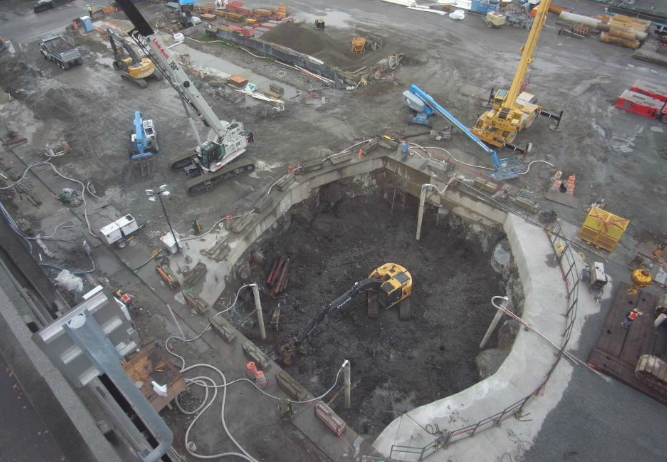One year ago today, an eight-inch-wide pipe went clunk, grind, and pfffth. Yes, it’s the anniversary of when Bertha, THE WORLD’S LARGEST TUNNEL BORING MACHINE, started to become the butt of jokes, world wide speculation, and persisent second guessing. After traveling for more than a 1,000 feet on her epic quest to drill a more than 9,000-foot long tunnel under Seattle, Bertha effectively came to non-grinding halt. The project is behind schedule, over cost, and even worse, a black eye in the fair face of Seattle’s ongoing quest to be a world class city.
The infamous pipe was 60 feet undergound and left over from a 2002 project to measure groundwater along the Alaskan Way Viaduct when Bertha attempted to gnaw her way through it. She wasn’t successful and instead pushed much of the pernsnickity pipe out of her way and kept digging for another three days. Bertha only stopped when she began to overheat. Her Twitter account of Dec 9 noted in an understatment: “Seeing some reports that I’m stuck. I’m working fine, but have encountered an obstruction.” Well, the reports were correct and she wasn’t actually fine.
WSDOT has longed claimed that the pipe was not the problem yet it seems rather peculiar that it took the tunnel gang one month to report the pipe to the public. As often happens, attemping to hide the truth gives a worse impression than simply being honest. It also seems curious and/or inept that they didn’t plan for the pipe, when they had documents showing where it was located. It makes sense that they could have done something about the pipe, like remove it.
Bertha has moved just a handful of feet since December 6, 2013. In the past year, we have learned that her main bearing seal was damaged. For some reason, contaminants had infiltrated the seal, making Bertha inoperable. Did the pipe harm the seals? Was it some unusual sediment? Was it something that won’t be discovered until they take Bertha completely apart and give engineers a chance to get their first complete look at the complete machine? At this point, we don’t know and one wonders if and when the lawyers will let us know.
We also don’t know when Bertha is going to be up and running again. The Seattle Tunnel Partners tells us that they are on schedule to start again in March 2015 but their track record does not necessarily lead one to believe that that will be the case. We’ll just have to wait and see, in what has turned into an epic story.
A few observations and questions.
- Engineers and crews have spent the past several months getting ready to take Bertha apart. Are they going to be able to put it back together correctly? How many of us have done something similar and not been able to repair the mess we made. And will they assemble it better than they did the first time?
- Did we get a lemon and did the contractor know it? As was pointed out last February, this wasn’t the first time Bertha had problems with her seals. They were also problematic in Japan, where she was built and where the problems were discovered during testing. Some have claimed that she wasn’t fixed right in the first place.
- This raises a follow up question after Bertha hit the pipe and began to overheat, why exactly was there the concerted push to keep her moving. Is it coincidental that Hitachi Zosen, the company that built Bertha, owns her for the first 1,300 feet, with Seattle Tunnel Partners taking ownership past that distance? If she had only gone another 300 feet, STP would face greater responsibility. Was there outside pressure to keep her moving beyond the 1,300 foot mark?
- What if it happens again, if a seal breaks or some other unexpected mechanical problem arises? As bad as the present situation is, it couldn’t have happened in much better of spot. Soon Bertha will be too deep to have a repair job on the order of the present one.
- Many have observed that the STP doesn’t appear to know what is under Seattle. According to geologists I spoke with, STP had and has a very good picture of what was and is under Seattle. (I wrote this before the report of water problems. I would still contend that they understand the geology but perhaps not the hydrology, which is very different and often much more complicated.) People have been digging up the city for decades and rarely do they find something that unexpected. (One might argue that the SLUT (South Lake Union Tusk) was unexpected but it really wasn’t. We know that mastodons, as well as giant sloths, lived and died here. They have been found before and will be again.) In a way, the tusk is similar to the oysters shells unearthed in October. It provides another detail to the story we mostly know, which is valuable, as it helps make the history of Seattle more fascinating and more accessible.)
- The archaeological work following Bertha’s stoppage has been one of the few positives. It has been done well but like Knute Berger, I wish that WSDOT archaeologists used the opportunity to do more than simply what is required. It would be great for them to see this as an opportunity to tap into resources they didn’t expect to see.
